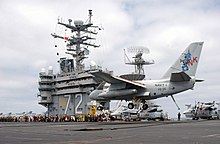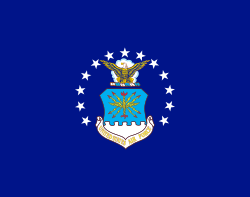Navy One
Navy One er flyvekontroltjenestens officielle kaldesignal på United States Navys fly, der befordrer USA's præsident.
Den 1. maj 2003 er eneste gang hvor Navy One har været i brug. Det skete da præsident George W. Bush skulle flyves fra Naval Air Station North Island ud til hangarskibet USS Abraham Lincoln ud fra kysten ved San Diego med det hangarskibsbaserede antiubådsfly Lockheed S-3 Viking.
Når vicepræsidenten er ombord er kaldesignalet Navy Two.
Se også
Eksterne henvisninger
| ||||||||||||||
Medier brugt på denne side
"Navy 1", a U.S. Navy Lockheed S-3B Viking (BuNo 159387) from sea control squadron VS-35 Blue Wolves lands aboard the aircraft carrier USS Abraham Lincoln (CVN-72) on 1 May 2003. The aircraft was carrying the U.S. president George W. Bush who was the first U.S. president land on an aircraft carrier in an airplane making an arrested landing. All other presidents (including Mr. Bush) had used a helicopter. The S-3B 159387 is today preserved at the U.S. Navy National Museum of Naval Aviation at Pensacola, Florida (USA).
Image taken from united-states-flag.com. This is a faithful representation of an original U.S. government work. As such, it attracts no new copyright. However, the USMC flag is protected by U.S. Trademark Registration Nos. 4852947 and 4193304, and may not be used commercially without a trademark license from the USMC's Trademark Licensing Office. Originally uploaded to en.wikipedia by Mbr7975; description page is (was) here: Marine corps flag.gif
(c) Zscout370 at engelsk Wikipedia, CC BY-SA 3.0
U.S. Presidential flag, 1960-present. It is defined in Executive Order 10860.
The Service Color of the U.S. Coast Guard. This is not the same as the law enforcement ensign, which features vertical red stripes defaced with the anchor symbol of the USCG.
The Flag of the United States Navy, as defined in Executive Order 10812 of April 24, 1959. The design is described there as:
The flag for the United States Navy is 4 feet 4 inches hoist by 5 feet 6 inches fly, of dark blue material, with yellow fringe, 2½ inches wide. In the center of the flag is a device 3 feet and 1 inch overall consisting of the inner pictorial portion of the seal of the Department of the Navy (with the exception that a continuation of the sea has been substituted for the land area), in its proper colors within a circular yellow rope edging, all 2 feet 6 inches in diameter above a yellow scroll inscribed "UNITED STATES NAVY" in dark blue letters.
The U.S. Navy flag is used for display purposes at ceremonies, parades, and other public functions where the U.S. Navy has an official presence, usually being carried by an honor guard on ceremonial occasions. It is not used for outdoor, fixed (permanent) purposes, and is not flown on Navy ships. Versions without fringe and different dimensions seem to be common, though it appears they are not technically the official U.S. Navy flag, as the executive order has not been amended.
Prior to 1959, the Navy Infantry Battalion flag was used to represent the U.S. Navy.
For more information, see the Navy's flag history page, SeaFlags, Flags of the World, U.S. Navy document NTP 13(B) [1], section 1710, and Navy regulation OPNAVINST 10520.1 (which replaced a similar SECNAVINST 10520.2D regulation from 1974).Det er let at give dette billede en kant








